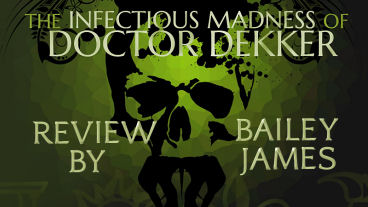
The Infectious Madness of Doctor Dekker Review
Dekker prominently bills itself as a “Lovecraftian murder mystery,” so it’s not much of a spoiler to reveal that the game doesn’t plant its feet firmly in reality. It’s not exactly a horror game, but it has surreal, dark elements that tangle themselves into the narrative







Genre: FMV Murder Mystery
Release date: May 19, 2017
Chances are if you’ve played many adventure games, you’ve been a detective. Donned a funny hat, faced a grisly crime scene, investigated, uncovered, deduced, accused. Sure, it’s good to have an idea of why someone committed a crime, but you’re most consumed by the how.
This is not the case in The Infectious Madness of Doctor Dekker, D’Avekki Studios’ first game. In Dekker, you wear the shoes of a psychiatrist. You’re the replacement for the freshly slain Doctor Dekker, summoned to continue the treatment of his cabal of increasingly afflicted patients. It’s likely one of them was his killer. So what’s a substitute psychoanalyst to do but start prying into psyches in search of a motive?
The game begins with you bleary and dazed, jostled awake in an office by your assistant. Your new patients are waiting, and they need your help! You start your interviews, digging into what each person’s “problem” is. There are plenty of garden-variety symptoms — restlessness, anxiety, depression, anger — but those issues come paired with stranger anecdotes that are more difficult to explain. One of the patients claims to be reliving the same day over and over again. Another believes that he gets an extra hour in his days during which time is stopped for everyone else. A third has mysterious blackouts and wakes up naked on the beach, unable to remember how she got there. The more you meet with your patients, the more they’ll come to trust you, and the stranger what they’ll tell you becomes.
The gameplay is straightforward: you’re presented with a list of your patients for the day, whom you can speak to in whatever order you choose. While they’re waiting for you to ask them something, the characters appear as phantasms on your poison-green couch, waving, strutting, posing, smirking, flirting, and tapping their watches to get your attention. You have a text bar at the top to type your questions. Introduce yourself, ask how they’re doing, and follow up on details that seem important.
To progress to a new day, you’ll have to sufficiently interrogate each character to uncover the essential details of the plot (turning a dot next to their names from red to amber). The game has accounted for players like me who are impatient to keep moving and need a helping hand. Asterisks next to questions asked indicate that a character has more to say on the subject, and when rewatching these response clips, the important keywords are italicized to indicate which part of an answer demands further prodding. The truly stumped can type “hint” to see a prompt of what question to ask next. Best of all, most of these settings can be enabled or disabled to adjust the game’s difficulty (I personally recommend checking out the options menu after you’ve played for a few minutes and customizing it to your liking — don’t get through 80% of the game before realizing you can adjust the hint cooldown time from 90 seconds to 30 seconds, like some reviewers did).
As an avid gamer who’s been tearing through adventure titles since I was old enough to sit at my dad’s computer, I remember the heyday of Full-Motion Video (FMV) in the nineties. The gameplay style was defined by a spirit of amateurishness — the acting was often rigid and campy and the gameplay itself lacked much involvement by the player. Fun it was not. One of my most vivid gaming memories involves fruitlessly forcing my way through the gory Phantasmagoria, enduring the same face-tearing death sequence dozens of times.
Thus, imagine my surprise that FMV has seen a resurgence of popularity over the past couple of years. Her Story used the format in 2015 to slowly build a narrative through searchable video clips, and Dekker has pursued a similar idea in a more polished way. You’ll still be “searching,” but instead of combing an archive you’re having a conversation, trying to follow the breadcrumbs each person drops as you tunnel deeper and deeper into his or her mind. The people themselves are the puzzle.
FMV that uses keyword triggers can be temperamental. It’s easy for players to be on the correct path but feel like they’ve gone the wrong way because they aren’t hitting on the exact phrasing the developers input. Dekker has attempted to alleviate this problem by suggesting that using “language mirroring” is an effective tactic in getting patients to open up (basically, use the words they use to refer to certain things).
Ask a character a question that doesn’t land and they’ll pull from a list of befuddled answers, like “Is that something I should know about?” and you’ll be forced to keep guessing. There’s also the risk of guessing a keyword you weren’t supposed to find yet and learning something too soon. This only happened to me a couple of times, and the fact that the game is divided into days means it’s impossible to jump too far ahead.
Dekker prominently bills itself as a “Lovecraftian murder mystery,” so it’s not much of a spoiler to reveal that the game doesn’t plant its feet firmly in reality. It’s not exactly a horror game, but it has surreal, dark elements that tangle themselves into the narrative. Lovecraftian horror often questions the unknown and explores the nature of sanity and madness.
I thought the combination of these tropes with the context of a modern therapeutic setting was fascinating, and the game’s structure is built around these questions. Each character gives you the option to keep pushing, to dig past the surface questions into the meat of deeper consciousness. What you ask depends largely on what you believe. Are their psychokinetic abilities real, or imagined? By asking for more details about their powers, are you seeking to cure them of their abnormal thinking, or are you indulging a delusion? Should you be protecting these patients, or their potential victims in the outside world?
I don’t want to give too much away about how these questions are handled, but I was impressed at the way the game creates so many ambiguities and holds players responsible for their decisions.
My only real gripe with this game was in its ending. I spent about twelve hours digging into the story, getting to know the characters and building my understanding of Dekker’s place in their lives. I had uncovered a lot of secrets and felt I knew who was most likely to benefit from killing the therapist. So I made a list of all the characters and ordered them from most to least likely to have committed the crime. When the game asked me to accuse someone, I picked my top choice. Wrong. I went to my next suspect. Also wrong. Third. Fourth. Fifth. Every one of the patients refuted my accusation. I was starting to feel like I was the one who had gone mad. Then, finally, when I guessed my sixth and final suspect, I triggered the ending. My least likely candidate had been the murderer.
What I didn’t know when I started playing was that there wasn’t one designated killer based on the events of the story. The murderer can be any of the six principal actors and is assigned at random at the beginning of a new game. While I had been questioning motives and relationships, I hadn’t realized that the proof of who your killer is lies in the corroboration of alibis, some of which are provided by side characters. Most of what your patients have entrusted you with, in a sense, doesn’t matter, and the ending that plays once you’ve guessed the culprit feels halting and short; insufficient after so many hours invested.
Don’t get me wrong, as much as I wanted to be a detective when I was in third grade, I’ve never had delusions about my own powers of deduction. I’m not bothered that the game stumped me. But I feel a bit cheated by the fact that the developers put so much time and attention into a story that they assert could have plausibly turned out six different ways. I don’t buy it, and I think it undercuts what they accomplished. Usually a game randomly assigns endings out of a desire to avoid spoilers, or to create replay value. But this isn’t Clue, where anyone could have committed the crime and the closest thing to a “motive” is being in the same room with a lead pipe. These characters had lives to risk.
Something interesting I discovered when reading about this game was that D’Avekki Studios hasn’t always been a video game company. They’re primarily the purveyors of mystery dinner party kits, the kind where a group of people dress up and linger over a meal trying to figure out who among them is a killer. This made a lot of sense to me — those paper-and-people games rely so much on their writing to give a story its life, but they usually have a single predetermined culprit. I suspect that since this was their first video game, D’Avekki Studios felt beholden to the genre and included several branching story paths as a result.
I think that if the studio wanted to create a more adaptive storytelling experience they could have done so in a way that remained truer to the integrity of their story. They could have kept the different outcomes based on each character and what they were made to believe by the questions your character asked (which worked effectively) but narrowed the list of possible culprits to two or three. Not all motives are created equal.
Dekker’s relationships with his patients were complicated. He was entangled in their lives — romantically, financially, psychologically — and left scars on the people he was supposed to be helping. It was a more complex portrayal of the therapist/patient dynamic than I was accustomed to. We’re used to patients sprawled feebly on fainting couches while a therapist scrawls notes on a clipboard. It’s one-sided and dimensionless and often merely a vehicle for exposition of a character’s backstory. But the game recognizes that such a relationship runs both ways.
The truth is that Doctor Dekker needed his patients just as much as they needed him. They seduced him, entertained him, drew him in, made him question his reality. They all had a mesmerizing power — not dreamwalking or time travel or reviving the dead. Their power was the ability to make a man believe that such magic might be possible.
This is why you should play The Infectious Madness of Doctor Dekker. Not because it’s well-acted and absorbing and well-written and ambitious, though all those things are true. But because it reminds us that the stories we tell spin the reality we live.
|
+ Absorbing acting performances (once you get used to one-sided conversations)
+ Tastefully utilized special effects
+ Well-calibrated text-based searching
+ Moral ambiguity
+ A unique perspective on the therapist/patient relationship
– Weak ending that felt disconnected from the carefully-developed plot
|
 |
System Requirements
Processor: Pentium 4 SSE2 onwards (dual core)
Memory: 2 GB RAM
Graphics: Intel HD3000 or comparable
Processor: Intel
Memory: 2 GB RAM
Graphics: Intel HD3000 or comparable

Leave a Reply